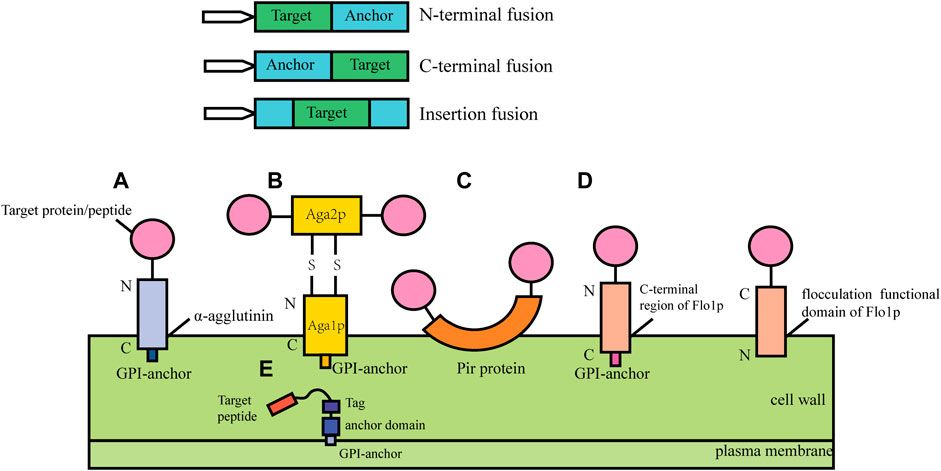Cell Surface Display-based Enzyme Directed Evolution is a revolutionary technology at the forefront of modern biotechnology. It involves manipulating the natural evolution process of enzymes to enhance their overall performance. This cutting-edge technology is incredibly important to study and understand due to its potential in various fields. The technology allows us to improve enzyme efficiency, stability, and selectivity. These improvements can dramatically impact industries such as pharmaceuticals, bioenergy, and environmental protection by making processes more efficient, sustainable, and cost-effective.
 Cell surface display systems in S. cerevisia (Chenmeng Zhang, et al., 2022)
Cell surface display systems in S. cerevisia (Chenmeng Zhang, et al., 2022)
Service Process
Our Cell Surface Display-based Enzyme Directed Evolution Service process is a multi-step procedure that includes:
- Consultation: Before the process begins, a consultation phase is essential. The scientists discuss the specific enzyme of interest, its projected improvements, and the potential challenges that might be encountered during the process.
- Engineered Display: The initial step involves the engineering of the specific enzyme of interest so that it is displayed on the surface of a host cell. This process is crucial as it allows the enzyme to be easily accessible for the subsequent steps.
- Directed Evolution: The next stage is directed evolution, where the host cell population displaying the enzyme is subjected to changes. This step is an attempt to mimic the natural evolution process artificially, but with a controlled and targeted approach.
- Induction of Genetic Variability: During the directed evolution, there is an induction of genetic variability within the host cell population. This means that changes are made to the genes of the cells, creating a variety of different genetic outcomes within the population.
- Selection of Improved Variants: Following the induction of genetic variability, the population is then scrutinized, and selections are made. The goal is to find and isolate variants that show improved function compared to the original. This could be higher efficiency, better resilience to conditions, or any other parameter that signifies an enhancement.
- Iterative Rounds of Mutagenesis and Selection: The process doesn't stop at one round of mutation and selection. It is repeated in iterative rounds, each time creating new genetic variants and selecting the ones with improved properties. This repetition is what pushes the 'evolution' aspect of the process, pushing the enzymes to become better over time.
- Evolution of Enhanced Enzymes: The final outcome of this rigorous and meticulous process is the evolution of enzymes with enhanced properties. These properties could range from higher catalytic efficiency, improved stability, altered substrate specificity, or any other desirable trait.
- Delivery: Once the enhanced enzymes are developed, they are delivered to the client. This could involve a physical delivery of the enzymes, or in some cases, sharing the genetic information of the improved variant for the client to produce in their own facilities.
- Post-Delivery Support: After delivery, the service typically includes support to ensure that the client can effectively use the enhanced enzymes. This might involve troubleshooting, further modifications if needed, or assistance with integrating the enzymes into their processes.
This process is a powerful tool in biotechnology and molecular biology, allowing scientists to engineer enzymes that are more efficient, robust, and suited to specific tasks or environments. If you have any questions, need more information, or would like to discuss a potential project, please don't hesitate to contact us. Our team is always eager to help and share our expertise.
Applications
| Application |
Description |
| Biofuels production |
Utilized in the development of enzymes for more efficient conversion of biomass into biofuels, improving the sustainability and viability of renewable energy sources. |
| Pharmaceutical drug development |
Facilitates the engineering of enzymes for the synthesis of pharmaceutical compounds, enabling the production of novel drugs or optimization of existing ones. |
| Bioremediation |
Applied in the creation of enzymes capable of degrading pollutants and contaminants in the environment, contributing to the remediation of polluted sites and ecosystems. |
| Food and beverage industry |
Used to optimize enzymes involved in food processing, such as improving flavor profiles, enhancing nutritional value, or increasing production efficiency. |
| Agricultural applications |
Employed in the development of enzymes for agricultural purposes, including enhancing crop yield, disease resistance, and nutrient uptake in plants. |
| Industrial biotechnology |
Applied in various industrial processes to engineer enzymes for improved performance in applications like detergent manufacturing, textile processing, and biocatalysis. |
FAQs
Here are some frequently asked questions about Cell Surface Display-based Enzyme Directed Evolution, our services, and the process we follow. If you have more specific or detailed questions, don't hesitate to get in touch with us directly.
Q: Could you provide a detailed explanation of Cell Surface Display-based Enzyme Directed Evolution?
A: Essentially, Cell Surface Display-based Enzyme Directed Evolution is a cutting-edge technology that harnesses and accelerates the natural evolution process of enzymes with the goal of amplifying their performance. This intricate process involves leveraging cell surface display technology to construct a vast library of enzyme variants. Subsequently, a high-throughput screening system is utilized to sift through these variants, identifying and selecting the most effective enzymes for the intended purpose.
Q: Can you elaborate on the importance of studying this technology?
A: Delving into the study of this technology offers the potential to significantly enhance the efficiency, stability, and selectivity of enzymes. This, in turn, can catalyze monumental advancements in wide-ranging fields, including but not limited to pharmaceuticals, bioenergy, and environmental protection. As such, the significance of studying this technology cannot be overstated.
Q: What are some of the practical real-world applications of this technology?
A: The potential applications of Cell Surface Display-based Enzyme Directed Evolution are incredibly broad and far-reaching. For instance, in the pharmaceutical industry, this technology can be harnessed to engineer more effective drugs. In the realm of bioenergy, it can be utilized to bolster the efficiency of biofuel production processes. Additionally, in the field of environmental protection, it can contribute to the development of more effective waste treatment methods.
Q: Can you give a detailed breakdown of the service process?
A: Our service process is thoroughly comprehensive and meticulously tailored to cater to our clients' specific needs. We kick off with an in-depth consultation, where we invest time to gain a deep understanding of the project requirements. Following this, we move into the project planning phase, where every detail is meticulously thought through. Subsequently, we transition into the execution phase, where the actual work is carried out in accordance with the previously established plan. Upon the completion of the work, we deliver the final product to the client and stand ready to provide post-delivery support as and when required.
Q: Could you walk me through the technical route of this technology?
A: The technical route of this technology is a multi-step process that includes enzyme library construction, high-throughput screening, an enzyme evolution phase, and performance testing. Each of these steps plays a pivotal role in ensuring the successful implementation and performance of the technology.
Q: What would you say are the benefits of opting for your services?
A: We pride ourselves on offering end-to-end services, meaning we take care of everything from the initial consultation right through to the final delivery of the project. Our team is an ensemble of experts in the field who are committed to ensuring that all work is performed to the highest possible standard of quality.
Q: How does one go about initiating a project with your services?
A: To get the ball rolling, simply reach out to us to discuss your project requirements. Our expert team will guide you through the entire process, patiently answering any questions you might have along the way.
Q: What type of support can clients expect from you?
A: We are committed to providing robust technical support throughout the duration of the project. Our dedicated team members are always on hand and ready to assist with any issues, concerns or questions that may arise during the course of the project.
Q: What does the typical timeline for a project look like?
A: The timeline for a project can differ quite substantially depending on its complexity, scale and specific requirements. After gaining a solid understanding of your project needs, we will be in a position to provide a more accurate estimate of the expected timeline.
Q: How much would it cost to avail of your services?
A: The cost of our services is based on the unique specifics of each project. We highly recommend reaching out to us so we can provide a personalized quote that accurately reflects the scope and requirements of your project.

































 Cell surface display systems in S. cerevisia (Chenmeng Zhang, et al., 2022)
Cell surface display systems in S. cerevisia (Chenmeng Zhang, et al., 2022)